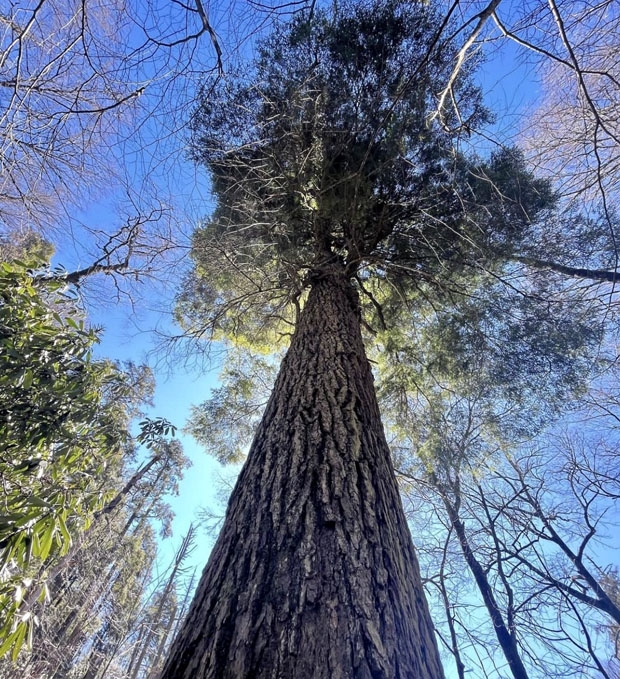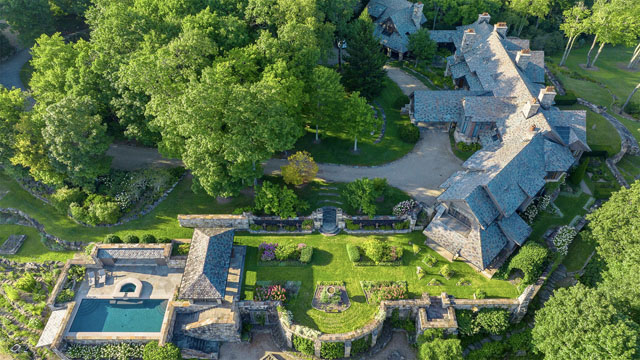The Remaining Titan of the Eastern Forests
05 Oct 2022
A story of Cheoah Hemlock preservation
Story and Photography by Kristin E. Landfield

Last March, in a protected pocket of wilderness outside Highlands, I found myself dumbstruck, mouth gaping, as my head tilted back to take in the colossal scale of the biggest hemlock tree I could imagine. The visit was an unexpected gift, as I was shown this special grove by a friend who had climbed and assisted treatment of this titan back in 2008. I couldn’t have fathomed the sense of wonder I would experience in seeing this mighty tree. For me, and certainly others who have visited and cared for this specimen, it’s hard to fathom that any built architecture could inspire awe and reverence like this towering cathedral of a tree.
Situated in the Nantahala National Forest, the massive Cheoah Hemlock is the largest known eastern hemlock (Tsuga canadensis) remaining. Rusty Rhea, with the United States Forest Service-NC, first identified and named it in 2004 during an aerial predator beetle release against Hemlock Woolly Adelgid (HWA). HWA is a devastating pest that started making its way south through eastern forests, arriving to this area in the early 2000s, where its rapid spread ravaged large populations of eastern and Carolina hemlock (for more detail on HWA and efforts to protect Southern forests, see our story in Plateau’s April/May 2022 issue). Champion tree hunter Will Blozan, cofounder of the Native Tree Society and president of Appalachian Arborists, noticed a subtle decline in the Cheoah’s vigor and commenced treatment efforts in 2006. Utilizing a variety of techniques, Blozan and team measured it to be 158.7’ tall, with an astounding canopy and trunk girth. Historically, Hemlocks rarely exceed 160’ in height. According to field research by the Tsuga Search Project, all 75 identified hemlocks above 160’ had succumbed to HWA by 2008, but Cheoah endured.
The sunken grove where the Cheoah Hemlock stands is part of the Kelsey Tract, a 271-acre vestige of what was once a vast old-growth hemlock forest. Protected by the Highlands-Cashiers Land Trust, this acreage averages approximately 4000 feet in elevation and is wedged between private lands and another section preserved by the Nature Conservancy. There is no public access to this tract. The Cheoah, an eastern species of hemlock, sits in a lower pocket surrounded by the native Rhododendron maximum (rosebay), Leucothoe fontanesiana (doghobble), Clethra acuminata (mountain pepperbush) and various ferns and galax. Carolina hemlocks (Tsuga caroliniana) tend to populate a little higher on wind-swept banks.
Blozan and colleagues have persisted in their protection efforts. Investments toward preservation benefit the entire ecosystem, as well as surrounding communities and economically essential clean water systems. In healthy forests, large native hemlocks keep water clean and cool; rising stream temperatures pose one of the biggest threats to Appalachian ecosystems. Commitment to protecting these stately trees yields incalculable downstream benefits at multiple levels of analysis. In 2020, the Hemlock Restoration Initiative (HRI) put forth a proclamation to continue faithful efforts to combat HWA, given the successful outcomes from prior endeavors. Although met with obstacles from the state governor’s office, HRI and allies continue to lobby for protection of these precious trees. Such efforts rely on both private donation and state funding.
The origins of this mighty specimen date back to around 1600 A.D., +/- 150 years. Recognizing the centuries it’s withstood, I’m humbled by this sacred giant, aware of the countless organisms it has nurtured. The Cheoah’s vast root system creates an entire subterranean universe. Standing beneath this stunning tree with its untold history, thoughts of policy, protection, or what I had planned for the rest of my day disappeared. I was held in time—heart full, mind empty—by the timeless character of the tremendous tree. As I stepped away from its seizing presence, trekking up a steep incline out of the forest, I’ve never been more certain that protection of such natural treasures is essential.
For more information on hemlocks and champion trees, visit
Hemlock Restoration Initiative (savehemlocksnc.org)
For donations, contact the Highlands-Cashiers Land Trust and specify Hemlock Woolly Adelgid treatment or care for trees in the Kelsey Tract. The oldest known Carolina hemlocks and black birch also reside in this threatened forest.













